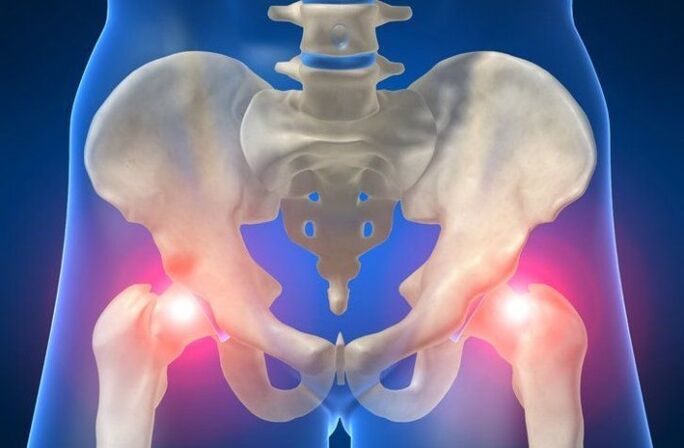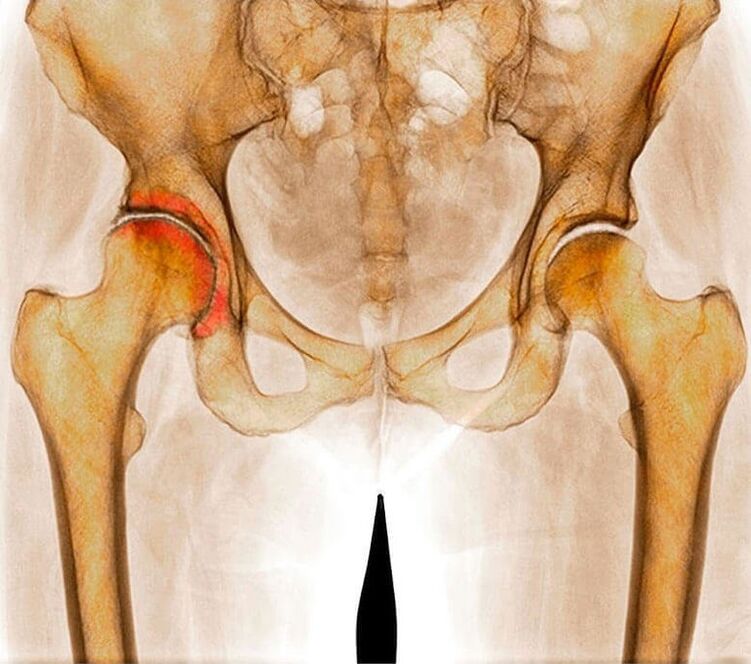The appearance of pain in the hip is a reason for an early visit to the doctor. The sooner the cause of the discomfort is identified and the treatment is prescribed, the higher the probability of getting rid of the pain completely.
The largest joint in the body is the hip. This is the largest and longest daily load. Its main function is to ensure human movement and maintain balance. Pain in the hip joint makes life difficult, brings many worries and problems.
If unpleasant symptoms appear, it is necessary to urgently consult a doctor for help. They can be caused by various diseases. Damage to the limbs is in the first position among the provocateurs of pain.
Less obvious factors that cause pain in the hip joint include the development of pathological processes. The main pathological causes of pain are:
- arthritis;
- osteoarthritis;
- infectious arthritis;
- inflammatory processes in tendons;
- coxarthrosis, etc.

If the treatment is not started on time, all these diseases cause complications, joint degenerative processes. These changes mainly include:
- damage to the cartilage surface;
- damage to structures located near the joint;
- decrease in the amount of fluid in the joint.
Often there are no obvious causes of pain in the hip joint, and the pain does not go away and increases every day. These are signs that indicate the presence of an already developed disease. You need to see a doctor to find out what disease is developing, but if this is not possible, you can first determine the symptoms and, accordingly, the pathology itself and the methods of getting rid of it.
Joint injury
The most obvious causes of pain in the hip joints are injuries. The most common fracture is the femoral neck. It is the most common because the neck is the thinnest area of the thigh. If the pain is caused by a fracture, then you need to be very careful, because this situation is very dangerous. Older people are more likely to get this injury.
Hip pain caused by a fracture should only be treated under medical supervision. In advanced cases, apply prosthetic or endoprosthetic methods.
Arthritis
This disease mostly affects the elderly. With age, the development of degenerative, dystrophic and inflammatory processes in the joints is often observed. This disease will cause pain in the hip and groin area, pain in the thigh, up to the knee may appear at night. The patient, leaning on a leg with a painful joint, feels an increase in pain, and when he gets up from a sitting position, he seems to hit his leg.

The pathology is common in elderly people. During this period of life, many people may experience all degenerative, dystrophic and inflammatory processes of the joints. One of the first to undergo changes is the hip joint.
The main symptoms of arthritis are:
- pain in limbs;
- pain in the inguinal region, spreading to the leg, reaching the knee region;
- increased symptoms while walking;
- shooting when rising from a sitting position.
What to do if the first signs of arthritis appear? Severe pain, high temperature, non-steroidal anti-inflammatory drugs should be taken. With their help, you can eliminate or eliminate the symptoms of the inflammatory process. Children are prescribed children's forms of medicines.
It is also necessary to rest the painful leg by placing it comfortably. Any progressive exercise is strictly prohibited. At the beginning of the development of the disease, the treatment is conservative. Surgery of prostheses or endoprostheses is performed in advanced cases.
Coxarthrosis
Coxarthrosis (deforming arthrosis) is a common pathology. The disease mainly occurs in people over 40 years old. The first symptoms with coxarthrosis can be seen from the beginning of its development. Pain sensations appear both in one and both joints and develop gradually. Coxarthrosis is divided into primary (a disease of unknown origin) and secondary, the causes are the consequences:
- congenital dislocations of the hip;
- necrosis and destruction of femoral head tissues;
- improperly set hip joint;
- Perthes disease;
- injury;
- inflammation.
In primary coxarthrosis, the spine and knee joint may be additionally affected. A change in the fluid that should lubricate the joint leads to the development of this disease. This causes the cartilage surface to dry out, resulting in roughness and cracks. During friction, the cartilages are thinned, the bones are subjected to great pressure, which causes their deformation in coxarthrosis.

The joint begins to hurt a little, but with the development of the pathology, discomfort begins to manifest itself with increasing intensity. In the second stage of the disease, severe pain is manifested by:
- every time you get up from a sitting position;
- upper body movements;
- the beginning of the journey;
- himself on a walk.
The pain spreads to the groin and knee area. There is constant muscle tone in the affected area. This explains the appearance of night pains.
Over time, blood circulation is disturbed, which causes the metabolism to slow down. This leads to gradual muscle atrophy. Symptoms of coxarthrosis in the 2nd and 3rd stages:
- pain in the hip joint, groin area, knee;
- limited movements;
- the appearance of lameness;
- the length of the leg with the affected joint is reduced;
- atrophy of thigh muscles.
Pain with coxarthrosis can appear even at night. Treatment should be prescribed by a doctor after a complete examination. The sooner the patient seeks help, the better and faster results will be achieved. They also resort to prosthetics and endoprosthetic methods.
When pain during walking is caused by arthrosis, drug treatment is possible only in the 1st and 2nd stages of development. Stage 3 requires surgery. You should not expect complete recovery (except for arthroplasty). However, it is possible to relieve discomfort and pain and stop the development of arthrosis. Medical treatment is carried out:
- pain relievers;
- anti-inflammatory;
- compresses using dimexide;
- physiotherapy.
But this treatment is not enough, complex therapy is needed. Thus, the doctor can prescribe massage, diet, gymnastics, and chondroprotectors.
Tendinitis and bursitis of the trochanteric bursa
The trochanteric bursa is located above the femoral shaft. Inflammation of this part of the musculoskeletal system causes pain in the hip joint and hip. If you lie on the affected side of the bag of fluid, the pain will intensify. The inflammatory process can also develop in the iliac-comb or ischial bags, but this happens less often. The development of the disease can begin after joint prosthesis and arthroplasty.
Tendinitis is an inflammatory process in the tendons. The risk of this pathology is in people who are under regular stress. Basically, this pathology appears in athletes.
Inflammation of the tendons causes joint pain during active movements or walking. In calm conditions and light loads, there can be no discomfort.
What to do when walking pain is caused by bursitis or tendonitis should be determined by an orthopedist or traumatologist. To save the patient from these pathologies, the specialist prescribes therapy aimed at eliminating inflammation. The affected limb should be given complete rest. Punctures are prescribed to relieve pain. During the procedure, fluid is removed from the bag and antibiotics are injected into it.
In advanced cases, surgical intervention is necessary.
To relieve pain, if chronic pelvic pain syndrome or mild forms of the disease are observed, treatment with alternative methods will help. Keep a few leaves of Kalanchoe in the refrigerator for a day, then squeeze the juice from them. Make a compress from it, it should be changed 6 times in the first few days, then you can apply it only at night.
Chronic pelvic pain syndrome from bursitis is relieved by compresses made from fresh cabbage leaves or burdock root. These leaves should be applied from the inside to the area previously lubricated with oil or cream. Then you need to wrap the compress with polyethylene, wrap it with a cloth. If such treatment is carried out daily, then the inflammation will decrease after 1-2 months.
infections
The causes of infectious arthritis are influenza viruses, streptococci, staphylococci and other pathogens. If the pain is caused by an infectious disease, then the development of other symptoms will not take long. Pain and swelling in the affected joint area will not help. Fever may develop, and pain will torment not only during walking, but also at the slightest movement. Even light touches will cause pain.
Tuberculous arthritis, which mostly affects the hip joint, causes slightly different symptoms:
- The pain first appears when walking. It is not strong, but extends to the knee or mid-thigh.
- Then hip movements are limited.
- There is swelling in the affected bone area.
Heredity
Chronic pelvic pain syndrome is hereditary. This is Perthes disease, which is more common in boys and more severe in girls. The disease affects one side of the hip joint, sometimes pain may appear in the knee.
The reason for the development of the disease is myelodysplasia (underdeveloped lumbar spinal cord). Pathology may not bother you all your life. However, serious violations cause various orthopedic pathologies. Perthes disease can be caused by:
- inflammation of the joint;
- injury;
- increased stress on the joints.
Symptoms of the disease:
- lameness;
- sharp pain in the knee joint for no reason;
- pain in the hip joint;
- change in gait;
- increase in temperature;
- blood test shows inflammation.
Treatment should be carried out under the supervision of a doctor and according to his recommendations. Patients with Perthes disease are prescribed long-term complex therapy.
Tumors
Joint bone tumor will cause pain in the hip joint. Their nature depends on the location and quality of education in tissues.
The causes of joint pain extending to the leg may be in the failure of the joint itself. This includes neoplasms in muscles or bones. The intensity of pain and the field of manifestation are different. It depends on the nature of the tumors (benign or malignant) and their location.
When pain appears in the joints, regardless of the cause of this symptom, you should seek medical help. After all, any articular disease in the initial stage can be treated conservatively without resorting to surgery. However, home treatment of the tumor process is unacceptable.



































